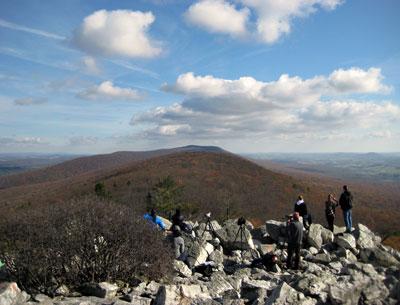Nature Notes: Escape to Hawk Mountain

We all know the names John Muir, Theodore Roosevelt, and James Audubon. Most us are familiar with the more modern names, Rachael Carson and Erin Brockovich.
But before those two came along there was another woman who almost nobody knows about, and until recently, neither did I. But she was one of several conservationist-environmentalist women who never received the accolades they deserved. Her name is Rosalie Edge. She was a life member of the American Audubon Society and she created the Hawk Mountain Sanctuary in Pennsylvania at the age of 56. She was also a feminist (when feminists were rare), a poet, and a bird lover. She established the sanctuary in 1934 by leasing 1,398 acres of rugged undeveloped mountain land in the Appalachians near Allentown in eastern Pennsylvania.
But why, and why there? It turns out that the particular piece of land was part of a much larger wild piece that once was occupied by the Unami tribe of the Lenape American Indians, the same Lenapes that were ancestors of the Shinnecock, Montauk, and other Long Island tribes. The Unamis lived off the ample supply of game, plants, and other “raw materials” in the area. Along came European white men and women in the late 1600s and they established a colony which remained small in population right up into the present day. They also lived off the land, and it was only sparsely developed.
In the early 1900s when passenger pigeons were on their way out, Hawk Mountain was known for its large number of migrating hawks, which, abetted by the updrifts from valley winds, soared either north or south during their annual spring and fall migrations. The hawks were so plentiful that they became the target for hundreds of shotgunners who killed them by the thousands as they flew past. In 1932 another strategic player named Richard Pough, who was a photographer, naturalist, and hawk lover, visited the site because he had heard that there were a large number of goshawks shot by hunters at the mountain at a time when each dead goshawk could be turned in to Pennsylvanian authorities for a $5 bounty.
He photographed the slaughter and his photo of hundreds of goshawks lying on the ground dead has become one of the medallions of the movement to stop the killing of raptors, which came to fruition in the 1960s largely based on his work. Throughout most of the 20th century, hawks were considered vermin that preyed on game birds and chickens. Almost none were allowed to fly past the hunters’ guns without receiving a blast of lead shot.
Edge was inspired by Pough’s photos and reports. She borrowed money, paid $2 an acre for the land, posted it and had it closely patrolled. As if overnight, the reign of terror was halted, very few Hawk Mountain hawks were shot in 1935 and thereafter. Today the Hawk Mountain Sanctuary comprising much of the Kittatinny Ridge is a mecca for both migrating raptors and birders. The number of hawks passing each day by species is recorded and tabulated by trained volunteers and their data is saved and published for all to see.
On Saturday and Sunday three women from East Hampton Town, Vicki Bustamante and Karen and Barbara Rubinstein, were on hand to observe the hawks and other birds passing through. The official count over the two-day period was as follows: Red-tailed and sharp-shinned hawks, 177 and 30, respectively, were the most common. There were 9 Cooper’s hawks, 21 red-shouldered hawks, 12 bald eagles, 2 golden eagles, a merlin, 2 goshawks, 9 northern harriers, 3 black vultures, and a few other individuals — an osprey and northern harrier, among them. All of the raptors along with several ravens were heading south without hardly a flap of their wings — the winds and their updrafts were so favorable for soaring and gliding, thus saving all of those calories for the rest of the flight ahead.
Golden eagles had passed by a week before in large numbers and broad-winged hawks, mostly in September. Rough-legged hawks and the goshawks are more northern and come through a little later, especially so in such a warm October and early November of the kind eastern America has experienced this year. A great-horned owl decoy with real glued-on feathers was seated on a post near the observers. Many of the hawks that flew by, especially the red-tails and sharp-shins, would dive at it as they passed. Vicki says it was the first time she had ever seen a red-tail turn its head back to see if the owl was in pursuit while still flying straight ahead after one such attack.
Along the way, the three observed two pileated woodpeckers, the largest of their genre in the United State, but not on Long Island. They didn’t see a coyote, except, perhaps, for a roadkill, saw bears, and smelled a skunk or two on the trip there and back.
One can see several different hawk species and a few bald eagles moving westerly along the ocean shore in September and October, but not in the numbers they move along Hawk Mountain. If it weren’t for unsung heroes like Rosalie Edge, Richard Pough, and the Audubon Society we would have far fewer hawks and eagles than we have now. All of the raptors are on the upswing.
Isn’t it puzzling that humans all over the globe are killing each other by the thousands daily? We have learned to spare the hawks and eagles; when will we apply that learning to save the human species? Perhaps never.
Larry Penny can be reached via email at [email protected].
